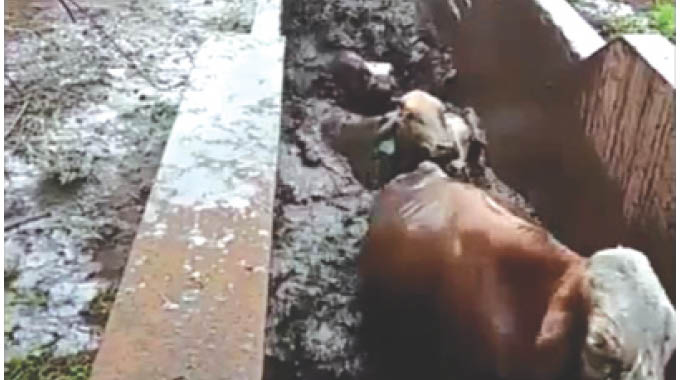Letters to the Editor: January Disease: Farmers must remain alert

Obert Chifamba
THE lull in Theileriosis or January Disease inspired cattle deaths does not signal the end of the problem, but a mere interlude that may easily turn into a holocaust and wipe away the remaining cattle if the right steps to contain it are not taken.
While it is not a secret that the cattle industry has lost in excess of 100 000 animals to Theileriosis, commonly known as January Disease because it is usually highly catastrophic during the month of January, the figure might actually be much higher, as the Department of Veterinary Services (DVS) is still compiling the statistics.
DVS is also still pursuing its investigations into allegations that some abattoirs have been receiving the sick animals, and slaughtering them for the unscrupulous people that have been selling the meat to unsuspecting citizens for consumption.
The department has since issued a stern warning that people should not eat, but destroy the cattle dying from the disease.
January Disease becomes noticeable starting December every year, peaks in January and usually ebbs in March. This is the period during which tick activities peak, as they find refuge in grass being nourished by rains, while cattle also cannot resist the temptation of devouring the green matter that comes with the wet season.
The disease is usually prevalent in Highveld areas that have high rainfall patterns that give birth to high tick activities too.
It is good to note that DVS has not been fooled by the disappearance of ‘“mbulances”’ (what people in Mhondoro had come to call the trucks that ferried sick cattle to their slaughter destinations), and dropped its guard, but has been boosting its capacity to handle the problem now and later.
“We have secured enough dipping chemicals to see us through the season,” Veterinary Services chief director Dr Josphat Nyika said in an interview recently.
“We have also distributed dipping chemicals to all the provinces across the country, thanks to the support we got from the Ministries of Finance and Economic Development and Lands, Agriculture, Water and Rural Resettlement.”
The icing on the cake is that the chemicals are being made locally and a number of companies that include Cooper Zimbabwe, Chemplex, Agroshape and Animal Health have since won the tender to manufacture the chemicals.
This means farmers can also get them locally and supplement what Government is providing through DVS if they feel that it is not enough.
They can buy Butalex or Butachem, which they can administer on their own and save their cattle.
To date, districts that have been affected the most by Theileriosis include Goromonzi, Marondera, Mhondoro, Chikomba, Hwedza, Buhera, Chivhu, Gutu, Chegutu, Centenary, Bindura and Shamva.
Signs and symptoms noticed on an animal affected by January Disease include swelling of the lymph nodes under the ears and on the shoulder, cloudiness of the eyes, difficulty in breathing with froth from the nose and mouth.
The affected animal collapses and dies within a few days. January Disease is a notifiable disease in Zimbabwe, and when suspected, farmers are compelled by the law to report to the Division of Veterinary Services. But it is not January Disease alone that is stalking cattle at this time of the year that farmers need to be wary of.
There is anthrax and lumpy skin disease, which are equally lethal if not prevented.
Anthrax is a soil borne zoonotic disease whose bacteria stays in the soil and when flash floods happen, they scrap away the top soil, allowing new grass shoots to sprout.
Naturally, cattle go for the emerging green stuff and pick anthrax spores together with the germinating grass. Anthrax can easily attack people too if they eat meat from the cattle dying from the disease, and may also kill such people.
An example of such a case was one in which some people from Zvimba District in Mashonaland West Province ended up being admitted at Chinhoyi Provincial Hospital after eating meat contaminated with anthrax.
Cattle that die from anthrax need to be buried in deep pits or even burnt, so that spores have no chance of getting to the surface where they can be eaten together with grass by grazing cattle.
Anthrax can survive in the soil for more than 40 years. After all has been said and done, there is speculation that the current anthrax problems are a result of anthrax that was introduced into the country by the Ian Smith regime in its efforts to starve freedom fighters of cattle that people killed to feed them. The anthrax was also reportedly expected to contaminate other food sources to indirectly kill the freedom fighters.
Dr Nyika stressed that his department ordered anthrax vaccines that are expected to be delivered this week, which bolsters his claims that they are geared to meet the problem head-on if it surfaces anywhere in the country.
Lumpy skin is caused by biting insects and can also kill cattle during this time of the year if detected cases are not acted upon with urgency.
It is also encouraging to know that there are powerful vaccines on the market across the country, which farmers can use to control lumpy skin disease. The disease is purely a management disease that requires the farmer to act to save his animals and is different from anthrax that has a Government vaccination programme meant to contain possible outbreaks.
It is, therefore, the farmers’ responsibility to always check their cattle for signs of the disease and act quickly, but they also need to alert DVS of any such cases.









Comments